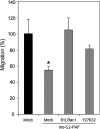Glycosidated phospholipids: uncoupling of signalling pathways at the plasma membrane
- PMID: 20331609
- PMCID: PMC2860204
- DOI: 10.1111/j.1476-5381.2009.00626.x
Glycosidated phospholipids: uncoupling of signalling pathways at the plasma membrane
Abstract
Cell expansion and metastasis are considered hallmarks of tumour progression. Therefore, efforts have been made to develop novel anti-cancer drugs that inhibit both the proliferation and the motility of tumour cells. Synthetic alkylphospholipids, compounds with aliphatic side chains that are ether linked to a glycerol backbone, are structurally derived from platelet-activating factor and represent a new class of drugs with anti-proliferative properties in tumour cells. These compounds do not interfere with the DNA or mitotic spindle apparatus of the cell. Instead, they are incorporated into cell membranes, where they accumulate and interfere with lipid metabolism and lipid-dependent signalling pathways. Recently, it has been shown that the most commonly studied alkylphospholipids inhibit proliferation by inducing apoptosis in malignant cells while leaving normal cells unaffected. This review focuses on a novel group of synthetic alkylphospholipids, the glycosidated phospholipids, which contain carbohydrates or carbohydrate-related molecules at the sn-2 position of the glycerol backbone. Members of this subfamily also exhibit anti-proliferative capacity and modulate the cell adhesion, differentiation, and migration of tumour cells. Among this group, Ino-C2-PAF shows the highest efficacy and low cytotoxicity. Apart from its anti-proliferative effect, Ino-C2-PAF strongly reduces cell motility via its inhibitory effect on the phosphorylation of the cytosolic tyrosine kinases FAK and Src. Signalling pathways under the control of the FAK/Src complex are normally required for both migration and proliferation and play a prominent role in tumour progression. We intend to highlight the potential of glycosidated phospholipids, especially Ino-C2-PAF, as a promising new group of drugs for the treatment of hyperproliferative and migration-based skin diseases.
Figures







Similar articles
-
Glycosidated phospholipids - a promising group of anti-tumour lipids.Anticancer Agents Med Chem. 2014 May;14(4):607-17. doi: 10.2174/1871520614666140309222845. Anticancer Agents Med Chem. 2014. PMID: 24628240 Review.
-
The novel synthetic ether lipid inositol-C2-PAF inhibits phosphorylation of the tyrosine kinases Src and FAK independent of integrin activation in transformed skin cells.Biochem Pharmacol. 2011 Apr 15;81(8):985-95. doi: 10.1016/j.bcp.2011.02.002. Epub 2011 Feb 12. Biochem Pharmacol. 2011. PMID: 21320472
-
The ether lipid inositol-C2-PAF is a potent inhibitor of cell proliferation in HaCaT cells.Chembiochem. 2006 Mar;7(3):441-9. doi: 10.1002/cbic.200500336. Chembiochem. 2006. PMID: 16453359
-
Impact of alkylphospholipids on the gene expression profile of HaCaT cells.Pharmacogenet Genomics. 2011 Jul;21(7):375-87. doi: 10.1097/FPC.0b013e32834549b9. Pharmacogenet Genomics. 2011. PMID: 21681147
-
Antitumor Lipids--Structure, Functions, and Medical Applications.Adv Protein Chem Struct Biol. 2015;101:27-66. doi: 10.1016/bs.apcsb.2015.08.001. Epub 2015 Sep 26. Adv Protein Chem Struct Biol. 2015. PMID: 26572975 Review.
Cited by
-
Synthesis of ether lipids: natural compounds and analogues.Beilstein J Org Chem. 2023 Sep 8;19:1299-1369. doi: 10.3762/bjoc.19.96. eCollection 2023. Beilstein J Org Chem. 2023. PMID: 37701305 Free PMC article. Review.
-
Tumor-Associated Glycans and Immune Surveillance.Vaccines (Basel). 2013 Jun 17;1(2):174-203. doi: 10.3390/vaccines1020174. Vaccines (Basel). 2013. PMID: 26343966 Free PMC article. Review.
-
Exogenous ether lipids predominantly target mitochondria.PLoS One. 2012;7(2):e31342. doi: 10.1371/journal.pone.0031342. Epub 2012 Feb 14. PLoS One. 2012. PMID: 22348073 Free PMC article.
-
Epigenetic crossroads in metabolic and cardiovascular health: the role of DNA methylation in type 2 diabetes and cardiovascular diseases.Cardiovasc Diabetol. 2025 May 29;24(1):231. doi: 10.1186/s12933-025-02800-x. Cardiovasc Diabetol. 2025. PMID: 40442704 Free PMC article. Review.
-
In vitro and in vivo anti-schistosomal activity of the alkylphospholipid analog edelfosine.PLoS One. 2014 Oct 10;9(10):e109431. doi: 10.1371/journal.pone.0109431. eCollection 2014. PLoS One. 2014. PMID: 25302497 Free PMC article.
References
-
- Andreesen R, Modolell M, Munder PG. Selective sensitivity of chronic myelogenous leukemia cell populations to alkyl-lysophospholipids. Blood. 1979;54:519–523. - PubMed
-
- Andreesen R, Modolell M, Weltzien HU, Eibl H, Common HH, Lohr GW, et al. Selective destruction of human leukemic cells by alkyl-lysophospholipids. Cancer Res. 1978;38:3894–3899. - PubMed
-
- Ausili A, Torrecillas A, Aranda FJ, Mollinedo F, Gajate C, Corbalan-Garcia S, et al. Edelfosine is incorporated into rafts and alters their organization. J Phys Chem B. 2008;112:11643–11654. - PubMed
-
- Baburina I, Jackowski S. Apoptosis triggered by 1-o-octadecyl-2-o-methyl-rac-glycero-3-phosphocholine is prevented by increased expression of ctp:Phosphocholine cytidylyltransferase. J Biol Chem. 1998;273:2169–2173. - PubMed
-
- Bartolmäs T, Heyn T, Mickeleit M, Fischer A, Reutter W, Danker K. Glucosamine-glycerophospholipids that activate cell-matrix adhesion and migration. J Med Chem. 2005;48:6750–6755. - PubMed
Publication types
MeSH terms
Substances
LinkOut - more resources
Full Text Sources
Other Literature Sources
Miscellaneous

